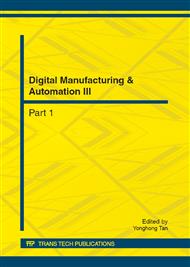[1]
G. Lorentzen. Revival of carbon dioxide as a refrigerant. International Journal of Refrigeration, 1994, 17(5): 292-301.
DOI: 10.1016/0140-7007(94)90059-0
Google Scholar
[2]
Liao SM, Zhao TS, Jakobsen A. A correlation of optimal heat rejection pressure in transcritical carbon dioxide cycles. Applied Thermal Engineering, 2000, 20(9): 831-834.
DOI: 10.1016/s1359-4311(99)00070-8
Google Scholar
[3]
Andy Pearson. Carbon dioxide—new uses for an old refrigerant. Int J. Refrig, 2005, 28(8): 1140-1148.
DOI: 10.1016/j.ijrefrig.2005.09.005
Google Scholar
[4]
YANG Junlan, MA Yitai, FENG Gang, et al. Optimization and Experimental Study on Transcritical CO2 Heat Pump System. Journal of fluid machnery, 2009, 37(1): 53-58. (in Chinese).
Google Scholar
[5]
XIE Yingbai, LIU Yingfu, TANG Jiancheng, et al. Transcritical throttling cycle of CO2 in two-stage compression with complete inter-cooling. Journal of Chemical Industry and Engineering, 2010, 61(3): 551–556. (in Chinese).
Google Scholar
[6]
James M. Calm. The next generation of refrigerants-historical review, considerations and outlook. International Journal of Refrigeration, 2008, 31(7): 1123-1133.
DOI: 10.1016/j.ijrefrig.2008.01.013
Google Scholar
[7]
Honghyun Cho, Changgi Ryu, Yongchan Kim, et al. Effects of refrigerant charge amount on the performance of a transcritical CO2 heat pump. International Journal of Refrigeration, 2005, 28: 1266-1273.
DOI: 10.1016/j.ijrefrig.2005.09.011
Google Scholar
[8]
Neeraj Agrawal, Souvik Bhattacharyya. Optimized transcritical CO2 heat pumps: Performance comparison of capillary tubes against expansion valves. International Journal of Refrigeration, 2008, 31: 388-395.
DOI: 10.1016/j.ijrefrig.2007.08.006
Google Scholar
[9]
Jahar Sarkar. Review on Cycle Modifications of Transcritical CO2 Refrigeration and Heat Pump Systems. Journal of Advanced Research in Mechanical Engineering, 2010, 1(1): 22-29.
Google Scholar
[10]
Cao Yong, Wu Jianfeng, Luo Ercang. Evolution and evaluation of research in vortex tube. Cryogenics, 2001, 6: 1–5. (in Chinese).
Google Scholar
[11]
HE Shu, WU Yuting, JIANG Shu, et al. Effect of nozzles on energy separation performance of vortex tube. Journal of Chemical Industry and Engineering, 2005, 56(11): 2073–(2076).
Google Scholar
[12]
E.A. Groll. Recent advances in the transcritical CO2 cycle technology. in: 8th National & 7th ISHMT-ASME Heat & Mass Transfer Conference, IIT Guwahati India, 2006. (in Chinese).
Google Scholar
[13]
E.A. Groll, J.H. Kim. Review of recent advances toward transcritical CO2 cycle technology. HVAC & R Research, 2007, 13 (3): 499-520.
DOI: 10.1080/10789669.2007.10390968
Google Scholar
[14]
D. Li, J.S. Baek, E.A. Groll, et al. Thermodynamic analysis of vortex tube and work output expansion devices for the transcritical carbon dioxide cycle. Fourth IIR-Gustav Lorentzen Conference on Natural Working Fluids at Purdue, Purdue University, USA, 2000: 433-440.
Google Scholar


